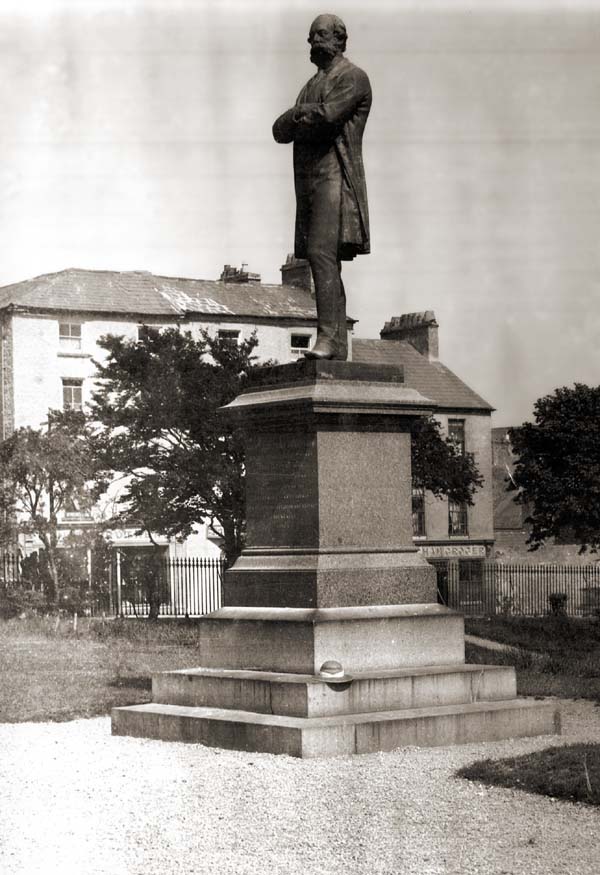In 1873, this imposing statue was unveiled in Eyre Square in honour of Lord Dunkellin, son of Lord Clanricarde, and heir to the family estates. He had a distinguished military career before being elected MP for Galway City in Parliament. He held the seat for 8 years before being elected for the County in 1865. He died in 1867. There was a very large gathering in the Square on the day of the unveiling with lots of toasts and speeches. The sculpture was a very fine one by the distinguished artist John Henry Foley.But if the artist was popular, the subject of his artwork was not. In the first place, Clanricarde’s tenants were forced to contribute to the cost.
During the Land War, Dunkellin’s younger brother, now Lord Clanricarde, was in the eye of the storm of the Woodford and other evictions. He was hated by his tenants and much of the population.
As soon as the British army evacuated Renmore Barracks, this statue became a target. The Galway Observer of May 27th, 1922 reported the following….
“On Thursday night, a crowd numbering several thousands assembled inside the Square, and two men set to work sawing at the base of the life-size bronze monument of Lord Dunkellin, a brother of the late Lord Clanricarde. A rope was afterwards procured and fastened around the neck, and with a strong pull, over it went amidst great applause. This monument was erected in 1873, and subscribed for by the Clanricarde tenantry, a good deal of which it was stated, was obtained from the people by threats. When the monument disappeared in the rere, the pedestal was mounted by Mr. W.J. Larkin, Mr. S.J. Cremin, Secretary of the Transport Workers Union, and Mr. P. Kiely, Secretary Galway Tenants Association.
Mr. Cremin made a lengthy speech in which he said they went before the Urban Council that day, and told them they would pull down that monument which had just fallen to the ground. It was a symbol of landlord tyranny, and they intended to pull down every monument of its kind in Ireland, and put a monument of some good Irishman in its place. The speaker then went on to denounce the present members of the Urban Council, and also the new magistrates as not being representative of the people, and being indifferent to the wants of workers. There was no justice to be had for the workers in the new courts any more than the old courts. They had, he said, 375 houses in town certified by a doctor as unfit for human habitation, and they had sewerage running into the main water pipe. At the Urban Council meeting that day, they wanted to see the schemes of the new houses, which they said was drafted, but they were refused a look at them, and he would not be surprised if those schemes were drafted in the back parlour of some landlord in town. The tenants of Galway were not out to abolish all landlords, and would not stop till they had every tenant the owner of a roof over his head.
After the meeting, a rope was put round the neck of the statue and it was drawn by thousands through the main streets with band playing Irish reels and hornpipes and taken out to the pier head where it was thrown into the water.
The scene at the pier head was of the most extraordinary kind. The thousands who followed (and dragged the ‘corpse’) cheering wildly. As the ‘body’ was being hurried into the sea opposite Devil’s head on the Claddagh side, Mr. Larkin stated that neither Gettysburg, Bodenstown or Greece had sufficient eloquence to panagerize such a ‘corpse’ ----- “Let it go boys” said Mr. Larkin “and may the devil and all rotten landlordism go with it”. As the body was hurried into the sea, the band amidst a roar of joyous laughter, played “I’m for ever blowing bubbles”.
The next morning, the statue had disappeared from the Quay Stream, removed by some enterprising person. It has never been seen since. The base was removed to Castlegar, reworked, and today ironically, it is a base for a memorial to the Old IRA.
Our thanks to Jonathan Margetts for today’s photograph.
TK
Please forward any queries/comments to This email address is being protected from spambots. You need JavaScript enabled to view it.
View the Old Galway Archive.

